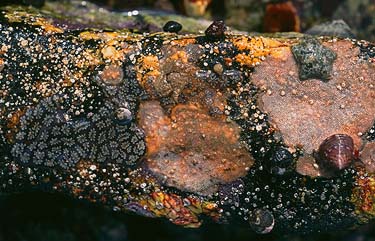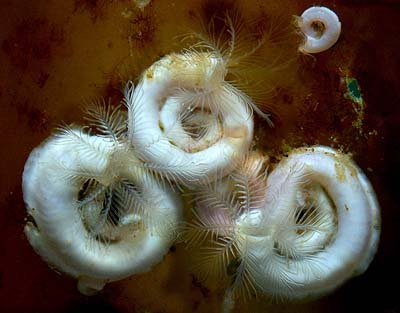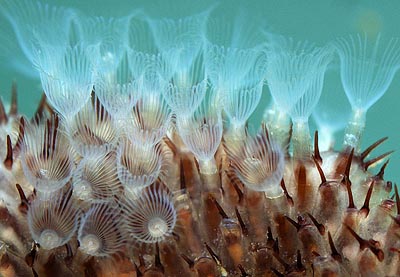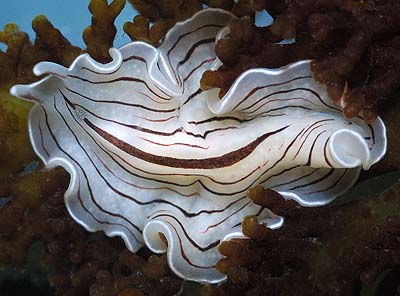Hidden Life in Tide Poolsby Wim van Egmond, the Netherlands |
 |
|
Most people like to spend their holidays stretched horizontal on a sandy beach. From this position sand can be studied in every detail. It is a fascinating subject. But for those who like to study living organisms, a better sea side holiday would be near rocky shores where we can find tide pools. Especially when the difference between high and low tide is at its peak (spring tide) we can spend hours walking on the bottom of the sea. In this little article I will show some of the marine organisms I photographed during a stay in Brittany, France. |
|
Turning stones will reveal interesting ecosystems. The underside of this stone gives protection to many marine invertebrates. After inspection the stone should always be placed in its orginal position. Otherwise the organisms will die. |
Life in the intertidal rocky shore can be divided into many zones. Each zone has its distinct species. High up near the coast we find the organisms that are truely adapted to an existence between land and water. Many sea weeds, barnacles and limpets can withstand the harsh conditions, not only the power of the waves but also the baking sun. Most organisms can be studied and photographed on the spot. For a close study (for example with the stereo-microscope) we can collect several organisms and place them in a little glass tank. The following three images were made with a microlens (a Leitz photar) attached to a digital camera (Nikon D70). The width of the image is 1 cm. |
|
We can find many organisms that live attached to stones and sea weeds. Very common are these small white coiled shells that are about 3 millimeter in diameter. They belong to the little Polychaete worm Spirorbis. It uses feathery tentacles to catch minute organisms. |
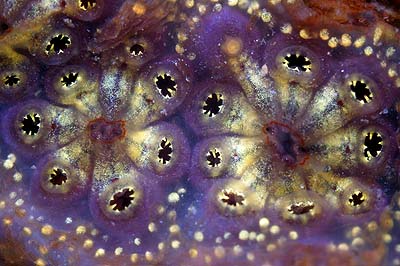 |
The
little stars we can see on the image of the stone are the colonial Tunicates. Botryllus
schlosseri. The genus is quite remarkable since the individuals
in the colony share a common cloacal opening. This
species can be found in many, often bright colours.
|
Another colonial organism that can be found growing on see weeds and stones are ectoprocts like this Membranipora. The tentacles are covered with fast moving cilia that create a current so the food is being directed towards the mouth. When disturbed they retract within their hard protective houses. |
|
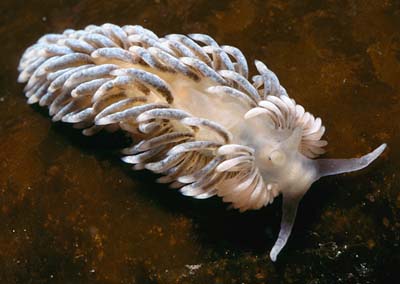 |
At very low tide we can find marine organisms of the deeper zones. This small nudibranch (sea slug) has many long projections. They are called cerata and the tips may contain stinging cells (nematocysts) that are obtained from digested hydroids. The two long sensory tentacles (rhinophores) are able to smell and taste. |
An inhabitant of the sea that can only be found when the tide is low is this delicately striped flat worm: Prostheceraeus vittatus. It may be mistaken for a nudibranch but it is very thin and this species is easily distinguished by the striped pattern. |
|
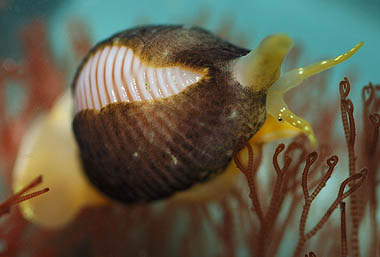 |
It is possible to find this unexpected mollusc, Trivia artica, a nothern living representative of this normally tropical group of molluscs. The mantle is partly covering the shell. |
see more examples of small marine organisms in Michel Salaün's article: Drawing Life of the Sea Shore
Visit the marine section of the Micropolitan Museum
Comments to the author Wim van Egmond are welcomed.
or visit Wim's HOME PAGE
Microscopy
UK Front Page
Micscape
Magazine
Article
Library
all material © Wim van Egmond
